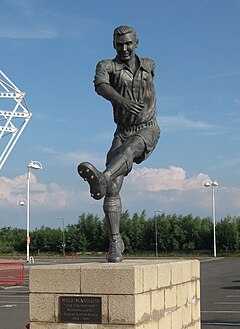Wilfrid James Mannion (16 May 1918 – 14 April 2000) was an English professional footballer who played as an inside forward,[1] making over 350 senior appearances for Middlesbrough. He also played international football for England. With his blonde hair, he was nicknamed "The Golden Boy".[2][3]
 Statue outside the Riverside Stadium of Middlesbrough F.C. | |||
| Personal information | |||
|---|---|---|---|
| Full name | Wilfred James Mannion | ||
| Date of birth | 16 May 1918 | ||
| Place of birth | South Bank, Middlesbrough, England | ||
| Date of death | 14 April 2000 (aged 81) | ||
| Place of death | Teesside, England | ||
| Position(s) | Inside forward | ||
| Senior career* | |||
| Years | Team | Apps | (Gls) |
| 1936–1954 | Middlesbrough | 341 | (99) |
| 1954–1956 | Hull City | 16 | (1) |
| 1956 | Poole Town | ||
| 1956–1958 | Cambridge United | ||
| 1960–62 | Earlestown (player/manager) | ||
| International career | |||
| 1939–1946 | → England wartime team | 4 | (0) |
| 1948 | England B | 1 | (0) |
| 1946–1951 | England | 26 | (11) |
| 1947 | United Kingdom | 1 | (2) |
| *Club domestic league appearances and goals | |||
Early life
editMannion was born on 16 May 1918 in South Bank, the son of Irish immigrants Tommy and Mary Mannion, and one of ten children.[3]
Club career
editMiddlesbrough
editMannion joined his local team Middlesbrough F.C. in 1936 and went on to make 341 Football League appearances for them, scoring 99 goals in the First and Second Divisions, over the next 18 years. However, his career was disrupted by World War II.[4] He scored 110 goals in all competitions for Middlesbrough.[5]
Mannion fought in France and Italy during World War II,[6][1] and in Italy his commanding officer was the England cricketer Hedley Verity.[6]
At the end of the 1947–48 season he wanted a transfer, but Middlesbrough refused. In protest he did not play for them for much of the following season but he eventually backed down and started playing for Middlesbrough again.[7]
Later career
editAfter initially retiring as a player in 1954, Mannion subsequently joined Hull City. However, the Football League suspended him for articles he had written,[8] He then played non-league football with Poole Town and Cambridge United.[9]
International career
editMannion was capped on 26 occasions by the England national team between 1946 and 1951, and his final appearance came on 3 October 1951.[10] He was a member of the England squad for the 1950 FIFA World Cup.[8] Along with Middlesbrough and England teammate George Hardwick, he was also part of the Great Britain football team that beat the Rest of Europe 6–1 in 1947.[11]
He remains the only Middlesbrough player to score for England at the World Cup.
After football
editMannion was eventually awarded a testimonial match by Middlesbrough in 1983, alongside former Boro and England colleague George Hardwick.[3]
Mannion died on 14 April 2000 at the age of 81.[7] After his death, Middlesbrough FC erected a statue of Mannion outside the Riverside Stadium.[3]
In 2004, he was inducted into the English Football Hall of Fame at the National Football Museum.[12]
References
edit- ^ a b English Hall of Fame Profile Archived 15 June 2009 at the Wayback Machine
- ^ N. Varley (2002) Golden Boy: A Biography of Wilf Mannion, Aurum Press Ltd, ISBN 1-85410-879-4
- ^ a b c d "The Original Golden Boy: The Wilf Mannion Story". This is the north east. communigate.co.uk. Archived from the original on 12 June 2011. Retrieved 30 July 2010.
- ^ Football League Career Stats at Neil Brown
- ^ "Wilf Mannion". 30 April 2001.
- ^ a b "Wilf Mannion". Spartacus Educational. Retrieved 23 June 2018.
- ^ a b Brian Glanville (15 April 2000). "Wilf Mannion". Obituary. The Guardian. Retrieved 12 September 2014.
- ^ a b "Wilf Mannion 1936-54". Middlesbrough FC. Retrieved 11 December 2011.
- ^ "The Golden Boy". 100 Years of Coconuts. Retrieved 19 April 2020.
- ^ "England's Players - Mabbutt to Murphy". England Football Online. Retrieved 28 December 2012.
- ^ "Great Britain v Rest of Europe, 10 May 1947". 11V11.Com.
- ^ "Hero duo get footballing honour". BBC. 4 November 2004. Retrieved 25 August 2013.
External links
edit- Profile at Spartacus Educational
- Wilf Mannion at National-Football-Teams.com
- Wilf Mannion at Englandstats.com